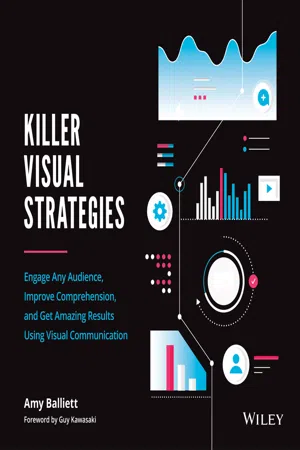
Killer Visual Strategies
Engage Any Audience, Improve Comprehension, and Get Amazing Results Using Visual Communication
- English
- ePUB (mobile friendly)
- Available on iOS & Android
Killer Visual Strategies
Engage Any Audience, Improve Comprehension, and Get Amazing Results Using Visual Communication
About this book
Discover the foundation, power, and necessity of visual communication with this essential guide
Visual communication has changed. It's gone from being an optional medium for relaying information to an important method for building connections and increasing understanding. We now use visual storytelling to help us establish and strengthen relationships, engage distracted audiences, and bring clarity to complexity. Killer Visual Strategies examines how visual communication has transformed how brands connect with their customers and colleagues alike. It looks at the growing audience demand for quality visual content and how organizations must meet this demand or risk being left behind.
Killer Visual Strategies traces the history of visual communication and explores why it now plays an integral role in our daily lives. As Amy Balliett tells the story of this evolving medium, she naturally incorporates visuals, such as timelines and data visualizations throughout. In addition to providing actionable rules to follow for creating high-impact visual content, Balliett also explores the latest trends, including visual search, augmented reality (AR), and virtual reality (VR). Then, she looks forward to what lies ahead in this dynamic field. The book's topics can benefit readers in a range of professions where visual content is now vital to sharing a message.
- Learn best practices for visual communication
- Gain inspiration from countless visual examples
- Stay on top of the latest trends in visual communication
- Understand visual communication for marketing, sales, design, HR, and more
Killer Visual Strategies provides a clearer picture of the evolution of visual communication as a fundamental part of how a story is told.
Frequently asked questions
- Essential is ideal for learners and professionals who enjoy exploring a wide range of subjects. Access the Essential Library with 800,000+ trusted titles and best-sellers across business, personal growth, and the humanities. Includes unlimited reading time and Standard Read Aloud voice.
- Complete: Perfect for advanced learners and researchers needing full, unrestricted access. Unlock 1.4M+ books across hundreds of subjects, including academic and specialized titles. The Complete Plan also includes advanced features like Premium Read Aloud and Research Assistant.
Please note we cannot support devices running on iOS 13 and Android 7 or earlier. Learn more about using the app.
Information
PART ONE:
VISUAL CONTENT IS KING

CHAPTER 1
ENVIRONMENTAL INFLUENCES AND THE RISE OF VISUAL CONTENT

ENTER A NEW MILLENNIUM AND THE RISING DEMAND FOR VISUAL CONTENT
Table of contents
- Cover
- Table of Contents
- FOREWORD
- INTRODUCTION
- HOW TO READ THIS BOOK
- THE ACCIDENTAL AGENCY
- PART ONE: VISUAL CONTENT IS KING
- PART TWO: 8 RULES OF VISUAL COMMUNICATION
- PART THREE: YOUR VISUAL STRATEGY
- POST-SCRIPT
- Appendix A: TERMS AND DEFINITIONS
- Appendix B: TOOLS
- Appendix C: PRODUCTION TIME ESTIMATES
- Appendix D: A TIMELINE OF VISUAL COMMUNICATION
- RESOURCES
- ACKNOWLEDGMENTS
- Index
- End User License Agreement